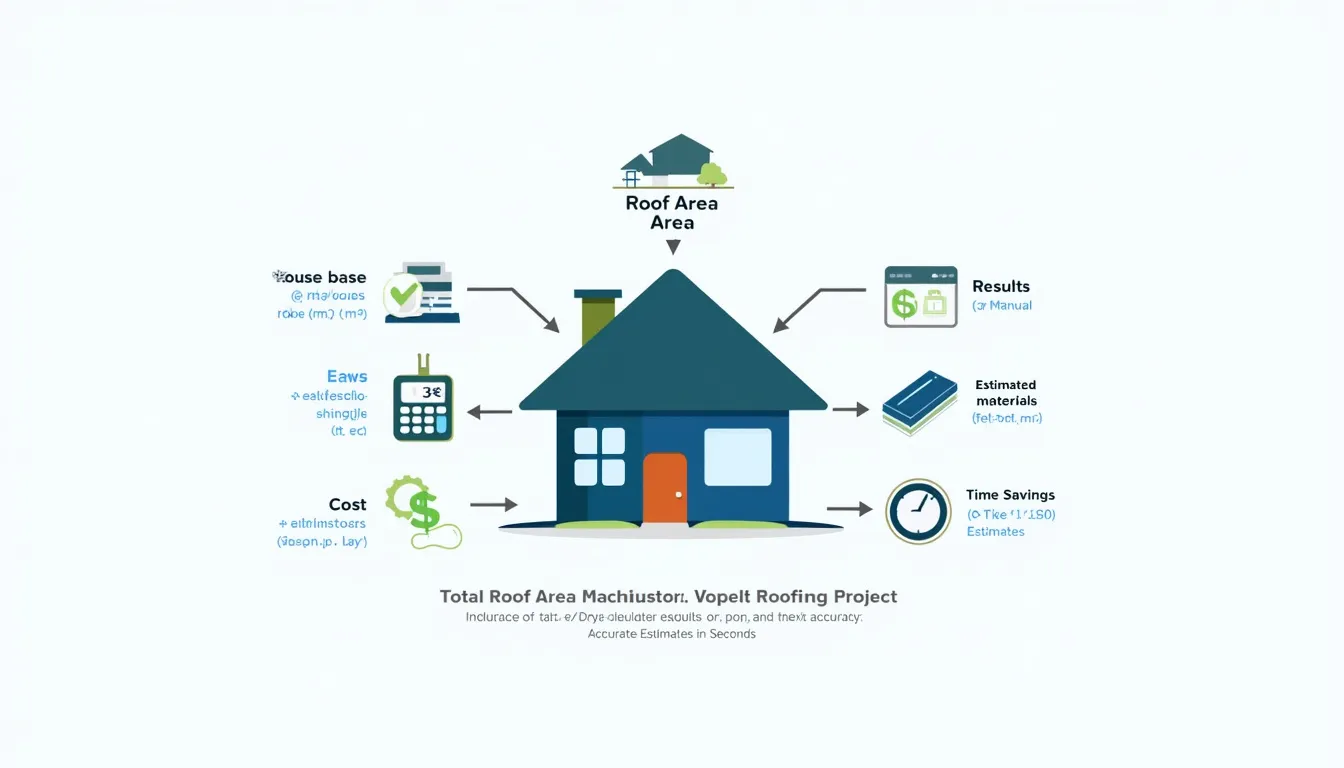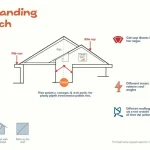Roof Area Calculator
Is this tool helpful?
How to Use the Roof Area Calculator Effectively
The Roof Area Calculator is designed to give you a quick and accurate estimate of your roof’s total surface area, helping with material planning and cost estimation. Follow these simple steps to get the best results:
- Enter the house base area: Provide the total footprint of your home in square meters. For example, you might enter 85 m² for a compact cabin or 120 m² for a suburban family house.
- Specify the eaves stick out: Measure how far your eaves extend beyond the walls in meters. Typical values could be 0.5 m for minimal overhangs or up to 1.0 m for larger eaves providing shade and rain protection.
- Select Roof Measurement Type: Choose between entering the roof’s pitch or its angle. This affects how you will input the next value.
- Input roof pitch or angle:
- If you chose pitch, enter the value in the format X/12. For instance, 6/12 or 9/12 to represent common roof slopes.
- If you selected angle, input the roof angle in degrees, ranging from 1 to 89. Examples include 25° for moderate slopes or 40° for steeper roofs.
- Optional: Enter price per square unit: Provide the cost per square meter or square foot of roofing material to get an estimated project cost. This might be $18.50 per m² for asphalt shingles or $25.00 for premium metal roofing.
- Click the Calculate button: The calculator will use your inputs to display the estimated roof area, material requirements, and approximate project price.
Following these steps ensures precise roof measurements and helps you plan your roofing project confidently and efficiently.
Understanding the Roof Area Calculator: Definition, Purpose, and Benefits
The Roof Area Calculator is a user-friendly online tool that provides accurate estimations of a roof’s surface area based on your home’s ground dimensions and roof design. It simplifies the otherwise complicated process of measuring roof space, helping homeowners, contractors, and roofing professionals alike.
This tool has several key purposes:
- Precise calculation of roof surface area to facilitate material ordering.
- Determining quantities of roofing materials needed for projects large or small.
- Estimating project costs when you provide material prices.
- Supporting efficient project planning and budgeting for construction and renovation.
By streamlining these processes, the calculator offers vital benefits including:
- Saving time compared to manual measuring and calculations.
- Reducing errors caused by complex roof geometries.
- Preventing material waste and costly over-ordering.
- Flexibility in working with different roof slopes and types.
- An intuitive interface that anyone can use, from homeowners to experienced contractors.
Example Calculation Scenarios Using the Roof Area Calculator
To understand how this calculator arrives at its figures, consider the following example calculations based on typical inputs:
Example 1: Calculating Roof Area Using Pitch
- House base area: 100 m²
- Eaves stick out: 0.7 m
- Roof pitch: 5/12
The calculator first approximates the house dimensions related to the base area, then adds the eaves overhang on all sides, increasing the width and length. Using the pitch value and the equation below, it calculates the slope length:
$$ a = \frac{\text{Width}}{2}, \quad b = a \times \frac{\text{Pitch}}{12}, \quad \text{Slope Length} = \sqrt{a^2 + b^2} $$Finally, the total roof area is computed as:
$$ \text{Roof Area} = 2 \times \text{Slope Length} \times \text{Length} $$This includes both sides of the roof, giving an accurate overall area estimate factoring in the pitch and overhang.
Example 2: Calculating Roof Area Using Roof Angle
- House base area: 150 m²
- Eaves stick out: 0.8 m
- Roof angle: 30°
When you input a roof angle, the calculator converts degrees to radians and applies trigonometry to find the length of the sloped roof side:
$$ \alpha = \text{roof angle in radians}, \quad c = \frac{\frac{\text{Width}}{2}}{\cos \alpha} $$Then multiplies this by the length and two slopes:
$$ \text{Roof Area} = 2 \times c \times \text{Length} $$This method suits low-slope and angled roofs where pitch might be difficult to measure.
Material and Cost Estimation
After calculating the roof area, the tool estimates required roofing materials, such as:
- Bundles of composition shingles (each covers approximately 33 ft²)
- Rolls of roll roofing (typical roll size ~3 ft × 36 ft)
- Rolls of #15 and #30 roofing felt underlayment
Material calculations include a 10% buffer for waste and overlap, helping you avoid shortages.
If you enter a price per square unit, the calculator multiplies the roof area by this price to give you an estimated total cost, assisting in budget planning and decision-making.
Why Use the Roof Area Calculator? Key Benefits for Your Roofing Project
1. Accurate and Reliable Measurements
Roof area calculation often involves tricky geometry, but this tool uses proven formulas and input validation to ensure accuracy. This reliability helps prevent common pitfalls such as overestimating or underestimating material needs.
2. Time and Effort Efficiency
Instead of climbing onto your roof or performing manual calculations, you only need a few basic inputs. The calculator performs all necessary trigonometric computations instantly.
3. Comprehensive Material Planning
The inclusion of shingle bundles, roll roofing, and felt estimates means you can prepare precise shopping lists that reduce waste and save money.
4. Flexible Input Options for Diverse Roof Types
Whether you have a traditional pitched roof measured by pitch or a modern design better suited to angle measurements, this calculator adapts effortlessly.
5. Valuable Cost Estimation for Budgeting
Input your material prices to quickly generate a project budget estimate, helping with cost comparisons and financial planning.
Practical Applications: Who Benefits from the Roof Area Calculator?
Homeowners Planning Renovations or Repairs
Whether you’re replacing shingles, installing solar panels, or repairing damage, accurate roof measurements help you order just what you need.
Roofing Contractors and Builders
This tool enables quick on-site estimates and professional quotes, improving client communication and project accuracy.
Insurance Adjusters and Claimants
Accurate roof area data allows for fair insurance claims by documenting the true extent of damage or replacement needs.
DIY Enthusiasts
The calculator makes roofing projects less intimidating by providing approachable, precise measurements and material lists.
Optimizing Your Roofing Project with This Roof Area Calculator
- Measure carefully: Use accurate base area and eaves measurements for the best results.
- Double-check roof pitch or angle: Confirm your inputs to avoid calculation errors.
- Factor in material waste: The built-in 10% buffer helps ensure you order sufficient supplies.
- Compare material costs: Adjust the price per square unit to evaluate different roofing options effectively.
- Plan for contingencies: Use the calculator’s flexibility to model roof area variations for complex projects.
The Roof Area Calculator is an essential resource for anyone seeking precision, efficiency, and confidence in roofing measurements, material planning, and cost estimation. Harness the power of this tool to make informed decisions, streamline your project, and achieve professional results.
Important Disclaimer
The calculations, results, and content provided by our tools are not guaranteed to be accurate, complete, or reliable. Users are responsible for verifying and interpreting the results. Our content and tools may contain errors, biases, or inconsistencies. Do not enter personal data, sensitive information, or personally identifiable information in our web forms or tools. Such data entry violates our terms of service and may result in unauthorized disclosure to third parties. We reserve the right to save inputs and outputs from our tools for the purposes of error debugging, bias identification, and performance improvement. External companies providing AI models used in our tools may also save and process data in accordance with their own policies. By using our tools, you consent to this data collection and processing. We reserve the right to limit the usage of our tools based on current usability factors.







